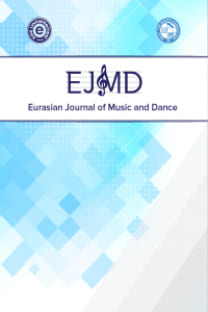CLAUDE DEBUSSY’NİN “BİR FAUN’UN ÖĞLEDEN SONRASINA PRELÜD” İSİMLİ ESERİ ÜZERİNE İNCELEME
Claude Debussy, Stéphane Mallermé, Bir Faun'un Öğleden Sonrasına Prelüd, İzlenimcilik, Sembolizm
Review on “Prelude to a Faune’s Afternoon” by Claude Debussy
Claude Debussy, Stéphane Mallermé, Prelude to the Afternoon of a Faun, impressionism, symbolism,
___
- Aktüze, İ. (2005). Müziği Okumak. İstanbul: Pan Yayınları.
- Boyana, H. (2005). Arkadia Kökenli Keçi Tanrı Pan. Tarih Araştırmaları Dergisi, 24(37), 67-193.
- Brown, M. (1993). L'Apres-Midi D'un Faune. Music Theory Spectrum, 15(2), 127-143.
- DeVoto, M. (2013). Memory And Tonality in Debussy’s Prélude À L’après-Midi D’un Faune. Cahiers Debussy. 2(7), 37-38.
- Cassou, J. (1994). Sembolizm Sanat Ansiklopedisi. İstanbul: Remzi Kitapevi.
- Code, D.J. (1999). Song Not Purely His Own: Modernism and The Pastoral Mode in Mallarmé, Debussy and Matisse. (Yayımlanmamış Doktora Tezi). University 0f California, Berkeley.
- Çöloğlu, M. E. (2006). Debussy'nin Müziği ve Sembolist Şiir. Sanat ve Tasarım, 7(11),112-142.
- Hons, T. (2010). Impressions and Symbols: Analysing the Aesthetics of Debussy's Practices within His Fin-De-Siècle Mosaic of Inspirations. Nota Bene: Canadian Undergraduate Journal of Musicology, 3(1),14-33.
- Kline, A. S. (2018). Stéphane Mallarmé Selected Poems. https://www.poetryintranslation.com/PITBR/French/Mallarme.php#anchor_Toc223495077
- Latham, E. D., Meglin, J. (2004). Motivic Design and Physical Gesture in L’après-Midi D’un Faune. Proceedings Of The Conference On Interdisciplinary Musicology. University of Graz, Graz, Avusturya.
- Melby, Julie L. (2011). Stéphane Mallarmé and Édouard Manet. http://www.princeton.edu/~graphicarts/2011/02/stephane_mallarme_1842-1898_la.html
- Selanik, C. (2010). Müzik Sanatının Tarihsel Serüveni. İstanbul: Doruk Yayıncılık. Альшванг, А.А. (1935). Клод Дебюсси. Moskova: Музгиз Yayınevi.
- Дымова, И. Г. ve Терновых, К. С. (2019). Симфонический Прелюд “Послеполуденный, Отдых Фавна” К. Дебюсси: Композиторские Открытия. Elibrari.ru, 64-71.
- Кенигсберг, A. (2015). Prélude à l’après-midi d’un faune. https://www.belcanto.ru/sm_debussy_faune.html
- Кремлёв, Ю.А. (1965). Клод Дебюсси. Moskova: Музыка Yayınevi.
- ISSN: 2651-4818
- Yayın Aralığı: Yılda 2 Sayı
- Başlangıç: 2011
- Yayıncı: Ege Üniversitesi
YAYLI ÇALGILARDA ESERE YÖNELİK YAY KULLANIMININ PLANLANMASI SÜRECİ
MEKTUPLARINDAKİ SÖYLEMLERİ EKSENİNDE KEMAL İLERİCİ (1910-1986) VE HAYAT MÜCADELESİ
Semih PELEN, Nilgün DOĞRUSÖZ DİŞİAÇIK, Melik Ertuğrul BAYRAKTARKATAL
KABAK KEMANEDE KULLANILAN SAĞ VE SOL EL TEKNİKLERİNE YÖNELİK EĞİTİMCİ VE İCRACI GÖRÜŞLERİ
LUDWIG BERGER VE WOLFGANG AMADEUS MOZART'IN ALLA TURCA ESERLERİNİN KARŞILAŞTIRILMASI
Mehmet Özgün TINAR, Özge GÜLBEY USTA
KLASİK GİTAR ÖĞRETİMİNE DÖNÜK HAZIRLANMIŞ MAKALELER ÜZERİNE BİR AÇIKLAMALI BİBLİYOGRAFYA (2012-2022)
Emre ŞENGÜN, Sami Emrah GEREKTEN
CLAUDE DEBUSSY’NİN “BİR FAUN’UN ÖĞLEDEN SONRASINA PRELÜD” İSİMLİ ESERİ ÜZERİNE İNCELEME
TÜRK KÜLTÜRÜNDE AĞIT YAKMA GELENEĞİ VE KAYSERİ’NİN AĞITÇI AVŞAR KADINLARI
SZYMANOWSKİ’NİN OP.42 MEFTUN MÜEZZİNİN ŞARKILARI ADLI ESERİNİN SÖZ VE MÜZİK BAĞLAMINDA İNCELENMESİ
CAGE ÖRNEĞİ ÜZERİNDEN MÜZİKTE “SESSİZLİK” OLGUSU VE YARATMA CESARETİ
